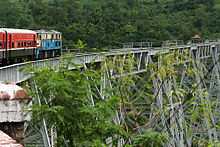Goteik viaduct
| Goteik viaduct ဂုတ်ထိပ်တံတား | |
|---|---|
 | |
| Coordinates | 22°20′35″N 96°51′35″E / 22.34306°N 96.85972°ECoordinates: 22°20′35″N 96°51′35″E / 22.34306°N 96.85972°E |
| Carries | 1 rail track |
| Crosses | Gohtwin Stream |
| Locale | Nawnghkio, between Lashio and Pyin U Lwin |
| Official name | Goteik viaduct |
| Other name(s) | Gokteik viaduct |
| Maintained by | Ministry of Transportation |
| Characteristics | |
| Design | Trestle[1] |
| Total length | 689 metres (2,260 ft) |
| Width | single rail track |
| History | |
| Construction begin | 28-4-1899 |
| Construction end | 1-1-1900 |
| Opened | 1-1-1900 |
| Statistics | |
| Daily traffic | Daily two trains. Mandalay to Lashio and Lashio to Mandalay. |
| Toll | USD 4,00/ MMK 3950 |
The Goteik viaduct (Burmese: ဂုတ်ထိပ်တံတား, also known as Gohteik viaduct) is a railway trestle in Nawnghkio, western Shan State, Myanmar (also known as Burma). The bridge is between the two towns of Pyin U Lwin, the summer capital of the former British colonial administrators of Burma, and Lashio, the principal town of northern Shan State. It is the highest bridge in Myanmar and when it was completed, the largest railway trestle in the world. The bridge is located approximately 100 km northeast of Mandalay.
The bridge was constructed in 1899 and completed in 1900 by Pennsylvania and Maryland Bridge Construction.[2] The components were made by the Pennsylvania Steel Company, and the parts were shipped from the United States. The rail line was constructed as a way for the British Empire to expand their influence in the region. The construction project was overseen by Sir Arthur Rendel, engineer for the Burma Railroad Company.[3]
Bridge data
The viaduct stretches 689 metres (2,260 ft) from end to end with 15 towers which span 12 metres (39 ft) along with a double tower 24 metres (79 ft) long. The 15 towers support 10 deck truss spans of 37 metres (121 ft) along with six plate girder spans 18 metres (59 ft) long and an approach span of 12 metres (39 ft). Many sources have put the height of the bridge at 250 metres (820 ft). This is supposedly a measurement to the river level as it flows underground through a tunnel at the point it passes underneath the trestle. The true height of the bridge as measured from the rail deck to the ground on the downstream side of the tallest tower is 102 metres (335 ft). The cost of the bridge construction was 111,200 £(Pound sterling).[4]
Due to its technical and natural condition it was considered as a masterpiece of the world standard.
Diversion
As the line from Mandalay to Lashio is of strategic value a diversionary route to the valley floor was built in 1976 - 1978, to keep trains running even if the Goteik viaduct was sabotaged. Its tracks were still visible from the viaduct in 2013, but the line has been left to the tropical vegetation since 2002.[5]
Mention
The bridge was mentioned in Paul Theroux's acclaimed travelogue The Great Railway Bazaar. He described the viaduct as "a monster of silver geometry in all the ragged rock and jungle, its presence was bizarre".
References
- ↑ "Gokteik Viaduct". Highestbridges.com. Retrieved 2011-03-11.
- ↑ Turk, J. D. (September 1901). "Building An American Bridge In Burma". The World's Work (New York, NY: Doubleday, Page & Co.) II (5): 1148–1167. Retrieved April 29, 2012.
- ↑ [History of rail transport in Burma]
- ↑ [|Nawnghkio township profile 2009 by Township Peace and Development Council]
- ↑ Dieter Hettler (1 November 2004). "Update from Myanmar". Railway Gazette International. Retrieved 1 May 2014.
| Wikimedia Commons has media related to Gokteik Viaduct. |